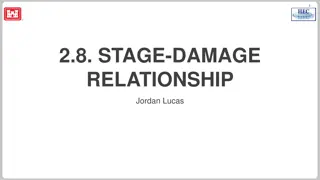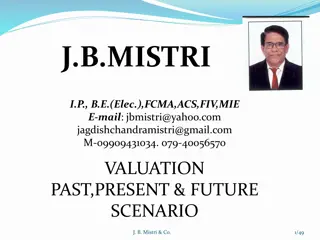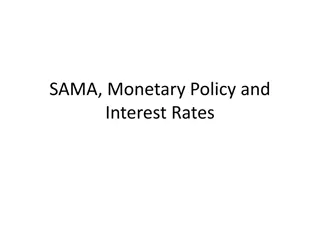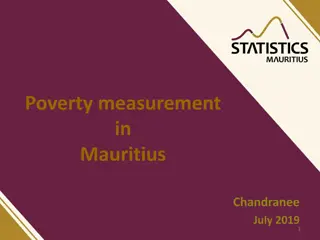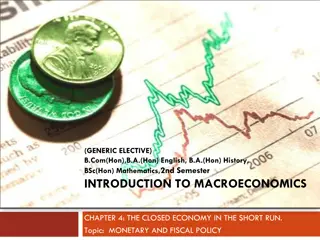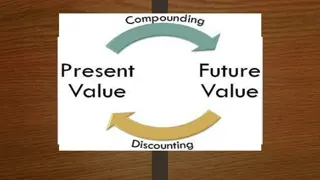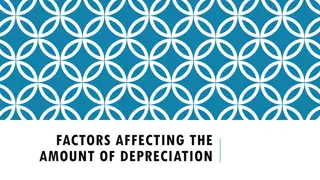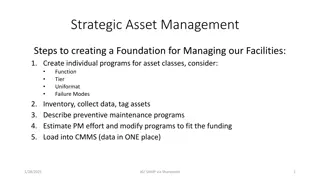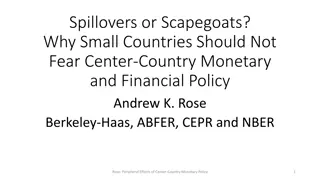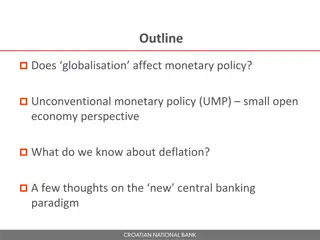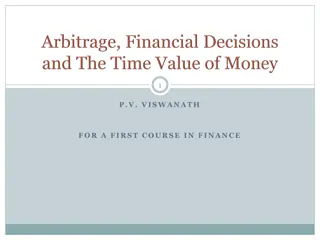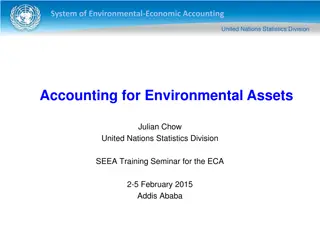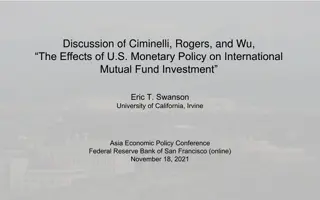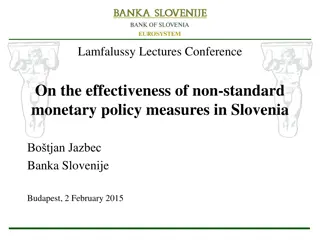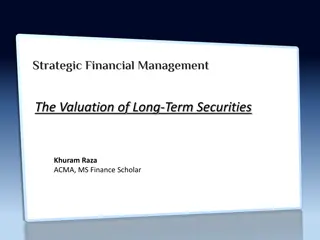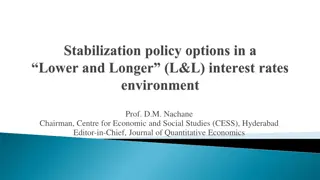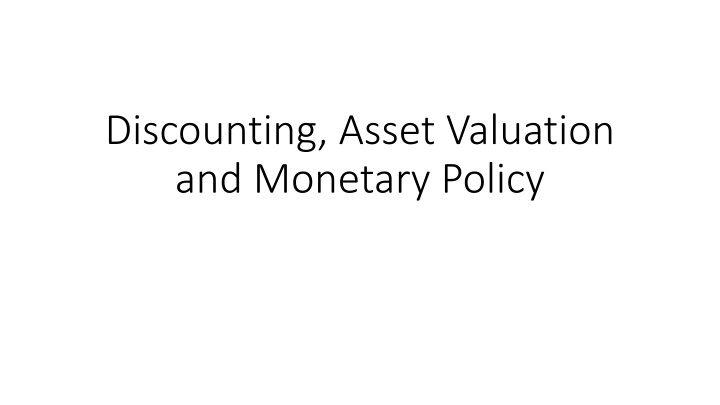
Discounting, Asset Valuation, and Monetary Policy
Explore the significance of discounting, asset valuation, and monetary policy in modern financial systems. Learn how low discount rates impact asset values and society's outlook on the future, and delve into the dynamics between short-term and long-term financial decisions.
Download Presentation

Please find below an Image/Link to download the presentation.
The content on the website is provided AS IS for your information and personal use only. It may not be sold, licensed, or shared on other websites without obtaining consent from the author. If you encounter any issues during the download, it is possible that the publisher has removed the file from their server.
You are allowed to download the files provided on this website for personal or commercial use, subject to the condition that they are used lawfully. All files are the property of their respective owners.
The content on the website is provided AS IS for your information and personal use only. It may not be sold, licensed, or shared on other websites without obtaining consent from the author.
E N D
Presentation Transcript
Discounting, Asset Valuation and Monetary Policy
Plan We will cover five parts 1. Summary 2. Discounting and asset values 3. Theory of discounting and monetary policy 4. Richard Cantillon and Cantillon effect 5. Tradeoff between short term and long term
1. Summary In modern financial system, discount rate is very low compared with history. Historically, interest rate is around 20%. Today credit card rate is still around 20%. But central bank discount rate is often around zero. Low discount rate increases asset value. Example: A perpetual bond has 6% coupon payment. When interest rate drops from 6% to 3%, bond value doubles.
Low discount rate increases value in the distant future. Suppose the discount rate is 10%. There is a 20 year par bond, which has a coupon rate of 10%. What are the values of cashflows from the first half and the second half? Calculation shows that value from the first half is 61 dollar and from the second half is 39 dollar. Suppose the discount rate is 1%. There is a 20 year par bond, which has a coupon rate of 1%. What are the values of cashflows from the first half and the second half? Calculation shows that value from the first half is 9 dollar and from the second half is 91 dollar.
Observation In a low discount rate environment, yield is low. Most values from assets come from distant future. People become extremely optimistic in a low discount rate environment. The key of success is to convince others about your own bright future. You have to have a talent of a great religious leader so people will have faith on you. In a low discount rate environment, frauds flourish.
Inflation is high. Increasing wealth gap between asset rich and asset poor. Young people are usually asset poor and old people are generally asset rich. Young people don t have financial means to support a large family. Fertility drops below replacement rate. Population ages and society declines.
Overall In a low discount rate environment, the society is obsessed with the future. There is no future.
Short term and long term impacts of monetary policies Monetary policies are the main tool governments and central banks use to fine tune economic activities. Lower interest rates will stimulate short term economic activities. Lower interest rates will also push up asset values. This makes people with more assets, typically older people, wealthier. This also makes people with less assets, typically young people, less able to acquire housing and other assets. This makes young people difficult to establish families. We will explore these issues in detail.
Interest rate, monthly payment and housing price Low interest rate policies are often used to lower mortgage payments. This makes housing more affordable over short term. But the same policies often make housing prices higher. Over long term, does low interest rate policies make housing more affordable?
Example 1 Suppose a house is bought for 400,000 dollars. The required down payment is 5% of the house price. The rest of the money is borrowed through a 30-year mortgage with monthly payments. What is the amount of down payment and what is the amount of borrowing? The annual percentage rate on the mortgage loan is 6%. Calculate the monthly payment. Now suppose the government tries to making housing more affordable. It reduces the interest rate to 3%. What is the new monthly payment on the mortgage? Does the government policy improve the affordability of housing market over the short term?
If the housing supply doesnt increase, those who can afford the monthly payment of the original 400,000 dollar house will likely to buy the same kind of house. Suppose down payment is still 5% of the housing price. What will be the new price of the house which was originally sold for 400,000 dollars, if monthly payment is kept at the same level when interest rate was at 6%? What is the new down payment? Over the long term, will lowering the interest rate alone improve or deteriorate the affordability of housing market?
Solution Down payment for the house, with 5% down payment 400000*5% = 20000 Amount remaining, that is the amount of mortgage 400000 20000 = 380000 Number of mortgage payment, a 30 mortgage with monthly payment 30*12 = 360 Monthly interest 6%/12 = 0.005 = 0.5%
The formula for calculating A, the monthly payment 1 1 + r n) 1 ( r = ( , , ) PV A r n A
Parameter values Total mortgage: PV = 380000 Number of payment: n = 360 Monthly interest rate, r = 0.005 Monthly payment, A = 2278.292
When the interest rate is reduced to 3%, we can redo the calculation with the same formula and different parameter values. Parameter values Total mortgage: PV = 380000 Number of payment: n = 360 Monthly interest rate, r = 0.0025 Monthly payment, A = 1602.095 The new monthly payment: 1602.095 dollar Over the short term, the low interest rate policy improves the affordability of housing.
However, people who can afford the original monthly payment can continue to pay the same amount. If there is no new housing supply, people will continue to pay the same amount for the same house. To maintain the original monthly payment of 2278.292 with the 3% interest rate, the present value representing the stream of payment is 1 1 + r n) 1 ( r = ( , , ) PV A r n A
Parameter values Monthly payment, A = 2278.292 Number of payment: n = 360 Monthly interest rate, r = 0.0025 Total mortgage: PV = 540386.7
From the above calculation, total mortgage becomes 540386.7, which represent 95% of the housing value. Housing value is 540386.7/0.95 = 568828.1 With this housing price, the new down payment will be 568828.1*5%= 28441.4 This is higher than the original 20000 down payment.
Discussion Over the long term, low interest rate policy will deteriorate the affordability of housing market. There is no magic in financial policies. Short term benefits have to be paid by long term costs. Specifically, short term low monthly payments have to be paid with long term high housing prices.
From generational perspective, higher asset value for the current generation increases the barrier for housing ownership for the future generations. In this example, we discussed how lower discount rate increases housing prices. Lower discount rate, by discounting cashflows with lower discount rate, will increase asset prices in general.
adjustable rates mortgage In adjustable rates mortgage (ARM), payments are adjusted during the life of mortgage. There is no down payment for ARM. Typically, in the first several years, only interest part is paid. After several years, principal is amortized, together with interest payment. This greatly reduces the cost of house buyers for the first several years. ARM is very popular for several years before 2008 financial crisis.
Example 2: An example of ARM A house is bought for 500,000 dollars. The mortgage rate is 3% per annum. The buyer chooses the adjustable rates mortgage that lasts for 25 years. In the first 5 years, the buyer only needs to pay the interest part. In the next 20 years, the buyer will pay back interest and principle with an equal monthly payment. What is the monthly payment for the first 5 years? What is the monthly payment for the next 20 years? Why people often default on adjustable rate mortgages? Suppose the housing price appreciates 15% over one year. If the capital investment is measured as the first 12 month s mortgage payment, what is the rate of return from this investment?
Solution Monthly rate 3%/12 = 0.25% Monthly payment for the first five years 500000*0.25% = 1250 dollar Monthly payment for the next twenty years ? = ? 1 1+?? = 1 1+0.0025240 = 2773 ?????? ? 1 500000 0.0025 1
Solution (Continued) People default on their mortgages because the monthly payment jumps greatly after five years. The amount of appreciation of housing price 500000*15% = 75000 dollar The amount of investment in one year 500000*3% = 15000 dollar Return on invest 75000/15000 1 = 4 = 400% Or 15%/3% - 1 = 4 = 400%
Excel calculations For Excel calculations, please check http://web.unbc.ca/~chenj/course/422/notes/notes.xlsx Sheet Monetary Policy, example 2 The following slide is the summary of the results.
House price mortgage rate monthly rate monthly interest payment duration for payment in principle and interest payment period monthly payment for the last 20 years percentage of capital gain total capital gain capital invested rate of return 500,000 3% 0.0025 1250 20 240 2773 15% 75000 15000 4.00
Highlights of the solutions The housing price is half million. There is no down payment. The initial monthly payment is only 1250 dollar. It is cheaper to own than to rent. This is why so many people choose to buy houses with ARM. After five years, the monthly payment rises to 2773 dollar, more than double the earlier payment. This is why many people default on their mortgages.
Highlights of the solutions (Continued) The rate of return on housing investment is 400%, an extremely high value. This is why investors love buying houses with ARM. Since ARMs are so popular with the customers, banks love to provide the service to earn high income. There is little incentive to be more prudent.
Discussion Many ARMs were initiated after 2001. Housing market peaked at 2006. Defaults occurred in a large scale from 2007 to 2008. Any relations? The movie and the book, The Big Short, offer good stories about that period of time.
Bond price change with different maturity Bonds have different maturities. Some mature in five years. Some last for thirty years. When interest rate changes, bond prices change. But the amounts of change are different for different bonds. How the price changes are related to the maturities of the bonds?
Example 3 There are two zero coupon bonds. The principal of both bonds is one thousand dollar. The maturities of two bonds are five years and ten years respectively. The initial interest rate is 8% per year. What are the prices of the five year bond and the ten year bond? When the interest rate declines to 6% per year, what are the new prices of the two bonds? What are the percentage changes of their prices?
Excel calculations For Excel calculations, please check http://web.unbc.ca/~chenj/course/422/notes/notes.xlsx Sheet Monetary Policy, example 3 The following slide is the summary of the results.
maturity in years 5 10 initial interest rate 8% initial price for zero coupon bond 680.58 463.19 new interest rate 6% new price for zero coupon bond 747.26 558.39 percentage of change 0.098 0.2055
Conclusion Long term bonds are more sensitive to interest rate change In general, long term projects are more sensitive to environmental changes.
Securitizing long term mortgages Financial industry securitize long term mortgages into mortgage bonds. They sell the mortgage bonds to many different investors. This reduces the risk of mortgage originators, such as banks. The reduced risk increases issuance of mortgages. The demand for more mortgages increases housing constructions and increases the sizes of houses. The increase of the sizes of the housing market increases the leverage of the economy. This sows the seeds for large scale financial crisis.
The concept of a discount rate is central to economic analysis Because of this centrality, the choice of an appropriate discount rate is one of the most critical problems in all of economics. And yet, to be perfectly honest, a great deal of uncertainty beclouds this very issue. The most critical single problem with discounting future benefits and cost is that no consensus now exists, or for that matter has ever existed, about what actual rate of interest to use. (Weitzman, 2001, p. 260)
The main problem in the theory of discounting is that an economist who knows the literature well is able to justify any reasonable social discount rate by some internally consistent story .
Some puzzles (Puzzle 1) The borrowing rates for banks are very low. But the credit card interest rates that banks charge their customers are very high. How can the large interest rate differential be maintained over a long time? From another perspective, individuals can obtain a line of credit or mortgage at much lower interest rate than the credit card interest rate. Why do so many people still maintain a large amount of credit card debt, without replacing it with a line of credit or mortgage refinancing?
Puzzle 2 Most economists are staunch proponents on the efficiency of markets, especially when a market is very liquid and transparent. The short term money market is among the most liquid and transparent markets in the world. Yet, most economists support that the short term discount rate, possibly the most important factor affecting economic performance, should be determined by a small group of independent professionals from central banks. Does that mean the market is only capable of being efficient on minor issues and not on major issues?
Puzzle 3 In general, yield curves slope upward. Loans with longer maturity pay higher interest rates than loans with shorter maturity. At the same time, empirical evidence suggests that humans discount the long term future at lower rates than the short term future. This pattern is called hyperbolic discounting. Many policy papers also advocate discounting long term projects at lower rates than short term projects. Why do market discount rates and psychological and policy discount rates move at different directions with the increase of project duration?
Puzzle 4 It is free to accumulate any amount of credit card debt, which often pay interest as high as 30%? This is defended as freedom of choice. Why it is mandatory for people to deduct their income for retirement, which typically yield very low return? From the deduction rate and payment rate, it can be implied the return on CPP (Canada Pension Plan), a government pension plan, is around zero. Why the pension deduction, which is mandatory, has been increasing over time?
Understanding these puzzles about discounting rates After presenting these puzzles, we will try to understand them one by one.
Human discounting rates Experiments Depending on the designs of the experiments, results vary. Overall, discount rates for humans are very high. If showed pictures of beautiful ladies before surveys, discount rates can be extremely high for men.
What determine human psychological discount rates? On the first puzzle For human beings, it is from our evolutionary past. In old times, the probability of death is high. Hence the discount rate into the future is high. Credit card rates, at about 30% per year, seem normal to many people. They don t have strong enough motivation to change to different methods of financing. This resolves the first puzzle.
On the second puzzle We have discussed earlier that human psychological discount rates are very high. We also learned that low discount rates stimulate economic growth. To stimulate economic growth, we need low discount rate, which can be most easily maintained by government actions.
In practice, governments, through central banks, provides lending to banks at low interest rate. All other interest rates are anchored around this low rate. Low discount rate environment increases equity value and encourages economic growth.
Summary In modern society, we prefer discount rates that are lower than human psychological discount rate. Low discount rate can be more effectively managed by central banks instead of directly determined by financial markets. This resolves the second puzzle.
Consequences of low discount rate policy Low discount rate policy benefits borrowers instead of lenders. As a result, saving rates in countries of low discount rates, which include all the wealthy countries, are low. It favors high fixed cost investments, as the borrowing cost is low Long duration investments are highly valued, as future earnings are highly valued. Fraud is rampant in a low discount environment. People can t assess distant future accurately.

